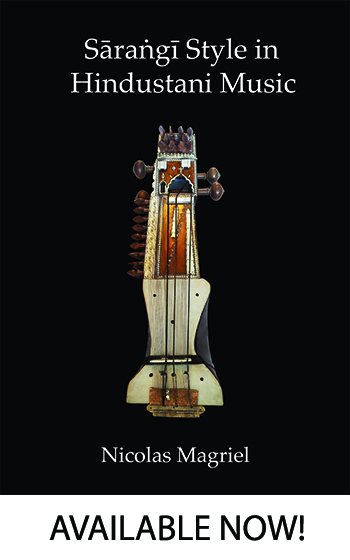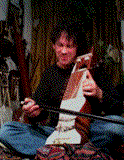
Dhruba Ghosh (b. 1957) was a good friend—a sarangi brother. He was a "Top Class" superb sarangi player with a deep understanding of music and an innovative style. We first met at the Sarangi Mela in Bhopal in 1989. Since then we met on-and-off whenever I was in Bombay, sitting with our sarangis, eating Chinese food, talking about music and philosophy. He taught me alot. He is one of the very few sarangi players who could speak communicative English. Dhruba Ghosh was the son of the great tabla player, Nikkil Ghosh who founded the Sangit Mahabharati music school in Juhu, Bombay. Dhruba grew up in an exceedingly musical environment. He learned tabla and vocal music as a child, and started sarangi relatively late—taking one lesson in technique from the outstanding Calcutta sarangiya Sagiruddin Khan—beyond that, he was self-taught. His solo playing was profoundly influenced by both Bundu Khan and Ram Narayan, and also, unusually, by instrumental (sitar and sarod) music. He was someone who tthought creatively and philosophically about music. Like Bundu Khan, he was a lover of paltas, note-permutation melodic exercises.
Having distanced himself from the Sangeet Mahabharati, in his later years, he lived part of each year in Brussels and the rest of the year in Mumbai, where he was Principal of the Bharatiya Vidya Bhavan. Aided by a Belgian luthier, Dhruba made innovations in the design of the sarangi, experimenting with a fourth (and a fifth!) playing string. He has engaged in many interesting fusion experiments with a wide variety of Western musicians. We last met, shortly before his tragically early passing, when he performed in a weird and eminently forgettable fusion group at the Green Note in Camden, London.
I never called Dhruba my teacher—we were friends, and I didn't want to upset that relationship. Our sessions were phenomenally peaceful and inspiring. This was some of the finest talim I ever recieved, certainly the most sensitive and finely atuned and deeply deeply musical. What music! I can only hope that some budding sarangi player somewhere makes a lot of use of these recordings.
NOTE: NEW VIDEOS ADDED BELOW 2024!
Our first video is a two-hour exploration of rag Kirwani at Dhruba Ghosh's home in Bombay on 9 January, 1996:
The next piece is Yaman, again with me following, 15 November, 1996 at the Sangit Mahabharati, Bombay.
The next video is from a month later, the 21st of December, also at the Sangit Mahabharati. We started with another Yaman. This was followed by Maru Bihag and Bageshri:
On 15 July, 1997, at Dhruba's residence in Bombay, we had a long detailed sitting in rag Todi:
This was followed by "hanging out"—conversation and Dhruba demonstrating various paltas and techniques:
Next we have three videos from a concert on 18 January, 1997 in Surat, Gujarat, beautifully accompanied on tabla by Aneesh Pradhan. For me, this was a wonderful experience travelling from Bombay to Surat with two superb musicians, hanging out with them, listening to their practice in the hotel and the green room, eating Chinese food. The performance was the icing on the cake. These videos have been made available courtesy of the performers.
The first piece was rag Kaushi Kanada:
The next piece was a thumri:
Dhruba Ghosh concluded with Bhairavi:
I feel priviledged to also be able to present Dhruba Ghosh practicing with Anish Pradhan before their concert in Surat, first in their hotel room and then backstage at the concert venue. These recordings offer a very special insight into the creative process at work in a special musician like Dhruba Ghosh. We see him consolidating his musical focus. Kaushi Kanada gradually emerges and gets refined snd polishe—the rag that will headline the concert.
In the hotel, Dhruba first played Yaman:
Followed by Jaijaivanti:
Then Kaushi Kanada and Jog:
Backstage, Dhruba and Anish again practised Kaushi Kanada:
This was followed by rag Kedar:
And then Dhruba returned to Kaushi Kanada for another few minutes. For sure this was now the chosen main rag for the concert:
The next video is an extended Vasant Mukhari played two weeks later in a concert in Gurgaon, Bombay on 2 February, 1997, accompanied on tabla by Yogesh Samsi, son of the distinguished vocalist Dinker Kaikani:
Then we have another sitting at the Sangit Mahabharati on 31 January, 1997. A false start in Gaud Malhar leads into an extended Jaijaivanti.
Then a beautiful Bhairavi in depth from 3 February, 1997:
Another sitting at the Sangit Mahabharati on 30 January, 1997, rag Ahir Bhairav:
And a very long and ponderous Marva sitting on 24 February, 1997:
NEW SEPTEMBER 2025! I have just salvaged and converted a Hi-8 tape which was overlooked in the initial digitisation process. Here Dhruba and I are playing alap, jor and jhala in rag Ahir Bhairav in hif flat in Bombay on March 2, 1997. A very serene and moving sitting:
Now we make a big jump to 2004 and the relative finesse of digital video. While I was working on The Songs of Khayal in Bombay, we met from time to time, played a rag or two and ate Chinese food. I think I said already, somewhere above, that in retrospect, I can see that my sittings with Dhruba were among the finest—the most refined—talim I ever had. He pulled me to a higher level of sensitivity, of aesthetic engagement with rags, and of technical precision. But I was busy with my research and learning singing, and I didn't work much on sarangi in those days. And looking back, this feels like a profound tragedy.
First a sitting on February 4th, 2004 at Dhruba's flat in Juhu, Bombay. We worked on Kalashri, a rag popularised by Amir Khan. Dhruba expands what is barely more than a single bandish in the mainstream imagination—into a deep and powerful melodic matrix.
Late that night we proceeded to rag Manj Khamaj, eventually morphing into Khamaj:
This was followed by some brief attention to rag Megh:
On the next three videos there is some unfortunate competition from the ceiling fan. On the 1st of March at my colourful place in Bandra (actually rented from the the actress Lisa Ray) we turned our attention towards rag Kaushi Kanada:
On the 25th of March, also at my place, we played rag Jhinjhoti:
Followed by another version of Kaushi Kanada:



